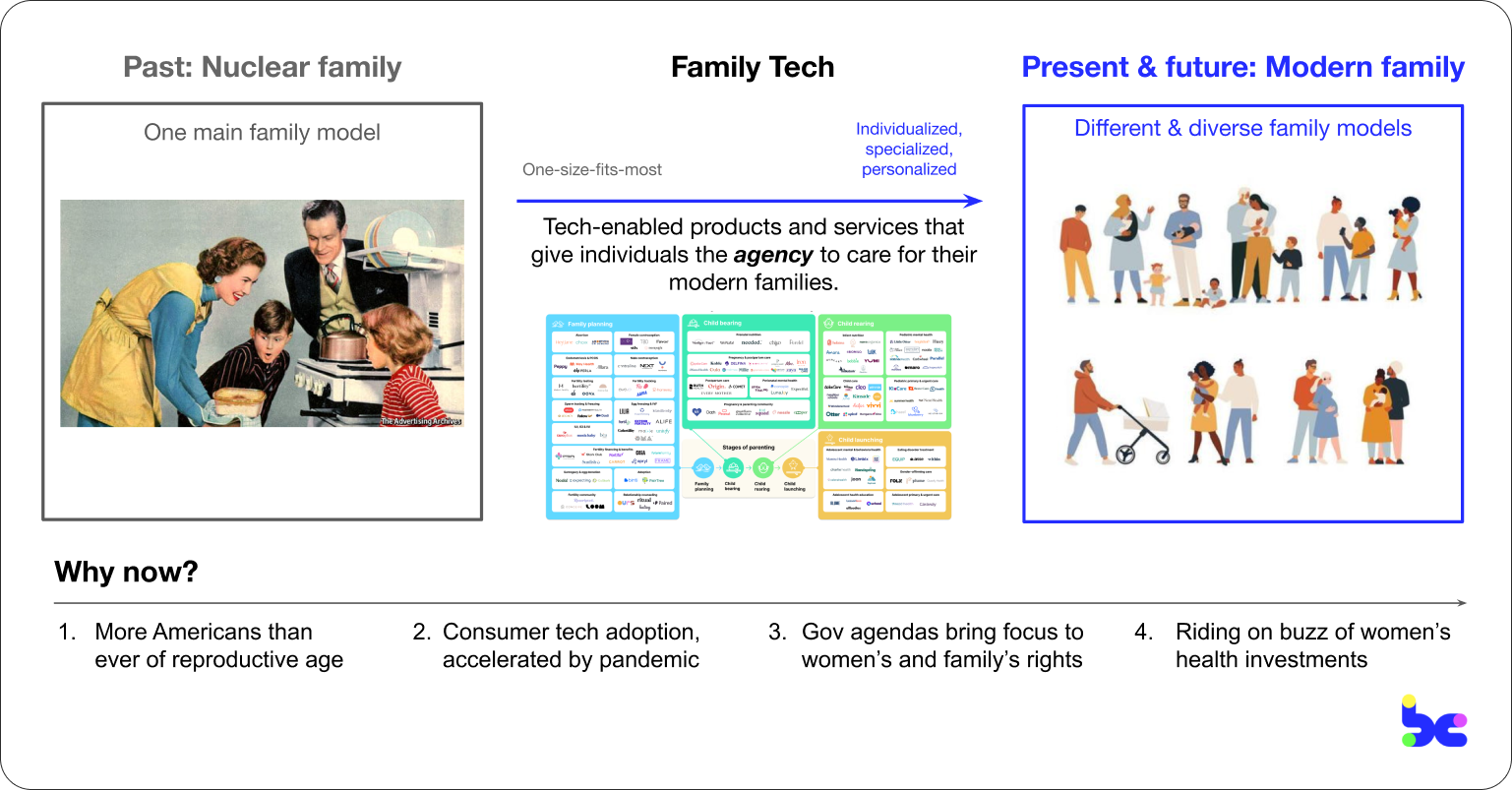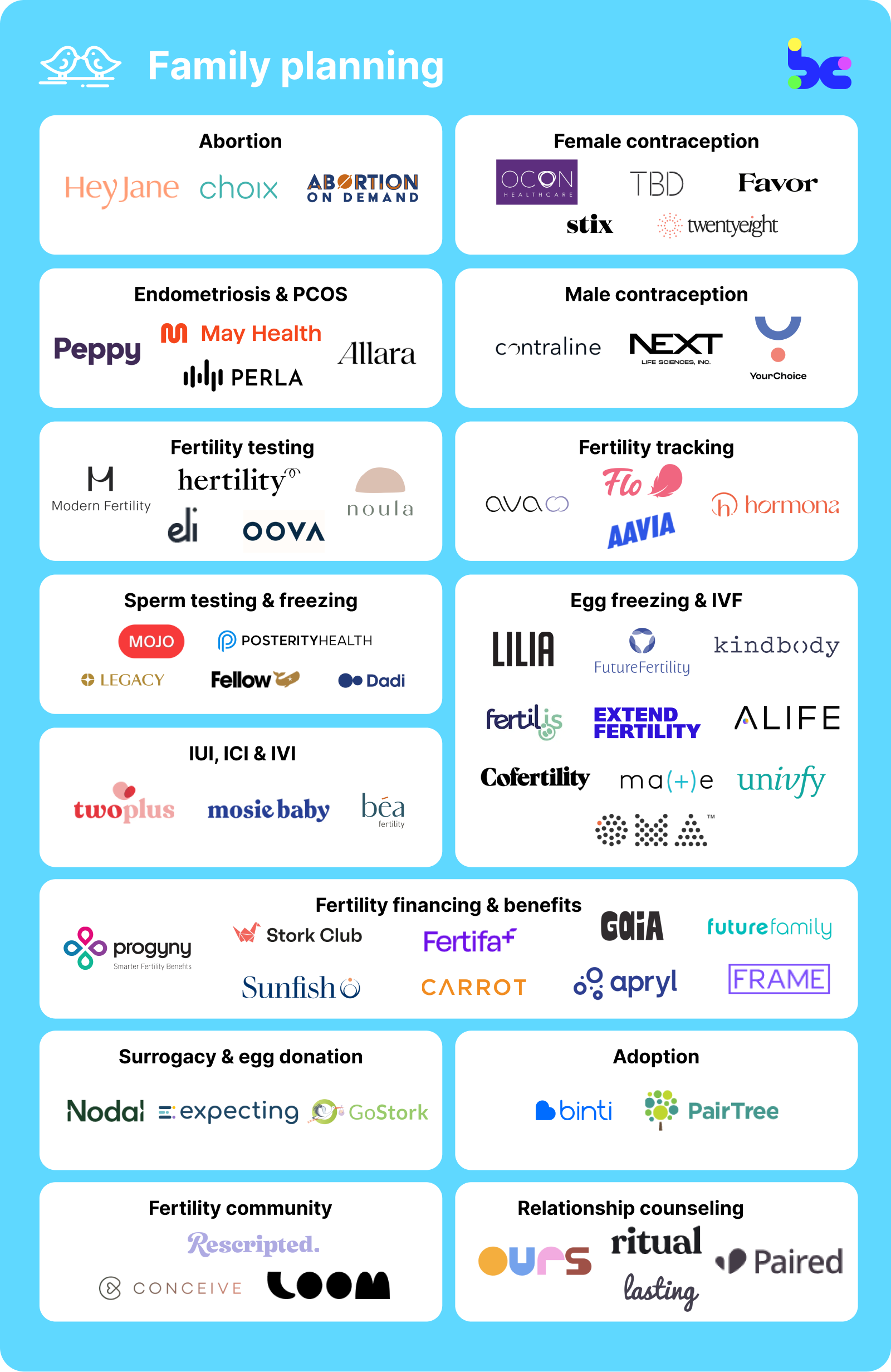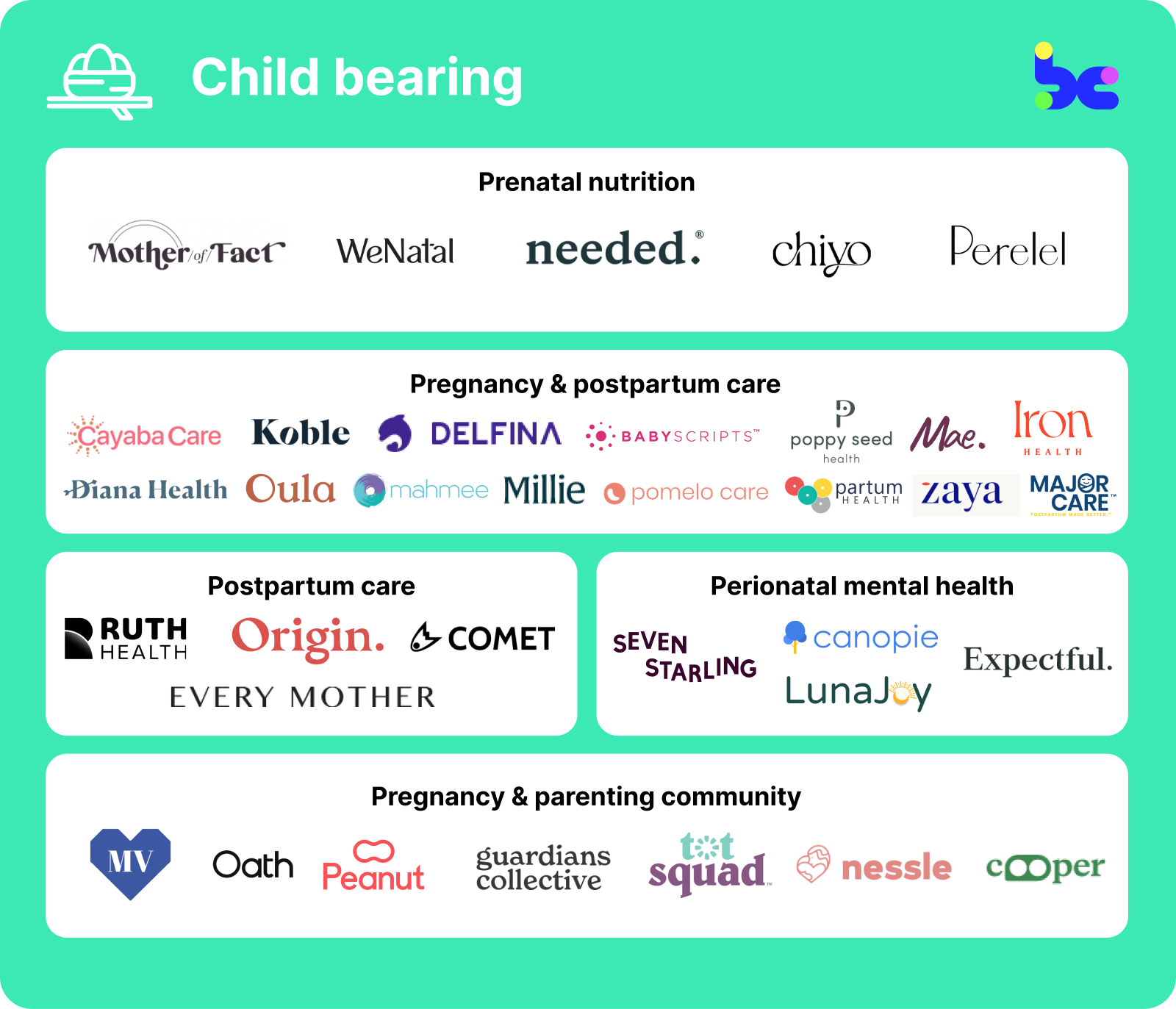Building to care for the modern family

Author’s note: This article serves as a primer on Family Tech, a new wave of tech-enabled products and services that give women, individuals, and parents the agency to care for their modern families. I make the case for how the traditional nuclear family has given way to different and diverse family models — “modern families” — and that now’s the right time to build and invest in the Family Tech enabling this paradigm shift. I’ll break down the stages, categories, and companies that are paving the way in Family Tech; and why you should care as a builder or investor. TL DR;

The nuclear family is dead, long live the modern family
The “nuclear family” was coined by Bronisław Malinowski, considered the father of social anthropology. He argued for the universal centrality of a biological family that looked something like this:

This term became popularized after World War II as a description of the standard family structure. There was the breadwinner male, his wife who did household chores and looked after the children, and the children themselves. There was an order in which this structure typically took form, too: the man and woman got married, moved in together, had sex, then had children — all before their mid-20s. The nuclear family was the core unit of society well into the 70’s.
Well, not anymore.
While the family is still the fundamental building block of society, millennials are rewriting the parenting playbook to form modern families. Unlike the nuclear family that had one singular blueprint for the family model, modern families take on many different shapes and forms — from single-parent and childless families, to same-sex couples and parents raising transgender kids.
The modern family seeks agency: Women, individuals and parents want to have the power to choose whether to have kids, how and where to give birth, where to go for flexible child care… (To butcher Tolstoy, “All nuclear families are alike; each modern family is modern in their own way.”)
With this paradigm shift in the family model, the healthcare and caregiving solutions have shifted as well to be more individualized, specialized, and personalized. You’re seeing it already. If you’re not ready for kids just yet, you can get contraceptives prescribed and delivered online. If you’re deciding on a home birth, you can sign up for a virtual consult with a midwife to walk you through options. If an urgent meeting comes up and you need child care ASAP, you can search through a child care marketplace for open spots at a center nearby.
There’s an outsized opportunity to build and invest in this new wave of tech-enabled products and services that give individuals and parents the agency to care for their modern families. This market is called Family Tech, a $46B and growing opportunity.
You can search through the Airtable below or read on as I break down 26 categories and highlight 175+ Family Tech companies building to care for the modern family.
This market map is meant to be a living document. You can contribute Family Tech companies directly via this form, and would love to hear your thoughts and feedback!
Mapping out the $46B Family Tech opportunity
Family Tech is not just a big opportunity; it’s one that’s deeply personal to me.
I’m lucky enough to have met and partnered with incredible Family Tech founders and builders through my work, as the Chief of Staff at Capable Health where we provide the software infrastructure for modern (family) care delivery, and as a Venture Fellow at Susa Ventures where we back exceptional Family Tech founders. I’m also a millennial woman who’s starting to assess her own family planning options.
To understand the opportunity as it is today, I’ve mapped out the Family Tech market across four stages of parenting: family planning, child bearing, child rearing, and child launching. I’ll identify the categories and companies that are paving the way in each, and why builders and investors should care.
But firstly, you may be asking the age-old question, “Why now?” There are four major tailwinds that’re enabling the paradigm shift towards the modern family and Family Tech:
-
There are more Americans then ever who’re making (or about to make) family planning decisions. Millennials (ages 26 to 41) represent America’s largest generation. They also happen to be the target demographic for Family Tech, as they’re both digitally savvy and of reproductive age. Right after Millennials come Gen Zs (ages 10 to 25), and together, they bring a new set of considerations to the modern family, ranging from climate change to student debt. That’s new opportunity to build Family Tech for these generations’ unique pain points and perspectives.
-
Consumers have adopted tech en masse and have higher standards for care than ever. Let’s face it, we’re hooked to our smartphones. Spurred on by the pandemic where we saw a 15x increase in the usage of telehealth services, consumers now expect virtual-first care that’s personalized, convenient, and high-touch. Consumers are more open than ever about adopting Family Tech.
-
Government agendas are shining a spotlight on reproductive, maternal and child care rights. All big trends in healthcare are driven by legislation and regulation, and Family Tech is no different. Notably, the Dobbs decision has created an urgent need for access to reproductive health care. CMS has been pushing states to provide postpartum coverage to people enrolled in Medicaid and CHIP. And while it ultimately failed to pass, the Biden administration’s Build Back Better Act promised to cap child care costs at 7% of families’ income. Government agendas have spotlighted white space opportunities for the modern family.
-
Family Tech rides on the tailwinds of women’s health investments. “FemTech” is a well-trodden, buzzworthy $38B market with unicorns like Maven Clinic and Tia as shining exemplars of why invest in the space. Investors already have their checkbooks open for women’s health companies, deploying $1.3B in funding last year, and have authored comprehensive theses including this one by Winnie Lau for M13 and this one by Rock Health. Family Tech is deeply intertwined with women’s health innovations given the important role women have as the child bearer and oftentimes primary caregiver. The buzz around FemTech has opened the door for Family Tech, too.
Now, let’s jump into the first stage of parenting…
Family planning

The modern family starts out with family planning. Whether single or in a relationship, individuals are looking to plan out and control how many children they want (if any) and when they have them.
Why you should care: There are more millennial women of childbearing age in the U.S. than ever. Yet, birth and fertility rates are at an all time low and the median age of women giving birth has been pushed back to 30 years old, a record high. Turns out, women and millennials are choosing to focus on their careers and education and delaying childbirth. Families also look physically different than they used to, with single individuals and same-sex couples wanting the options to have children.
This has fueled new technologies that capture and surface insights to make informed family planning decisions, prevent or increase the chances of pregnancy affordably and accessibly, open up alternative pathways to having a child, and provide longitudinal support through the end-to-end fertility journey.
The $8B fertility market is one of the most active spaces in Family Tech, receiving $345M of VC funding in 2021 alone.
Categories to watch:
- Abortion services like Hey Jane and Choix are navigating the aftermaths of the Dobbs decision to provide women with abortion pills and treatment when they need it most.
- Female contraception providers like TBD Health, Favor, and Stix make online prescriptions to birth control, morning after pills and other contraceptives discrete and convenient.
- Male contraception providers like YourChoice and Contraline racing to market to be the first male contraceptive.
- PCOS & endometriosis care providers like Allara, Perla Health and May Health are providing virtual-first treatment to the most common causes of infertility.
- Fertility testing including at-home testing services like Modern Fertility and Noula equip women with the insights on their reproductive health and fertility.
- Fertility tracking apps like Ava and Flo provide the software to track ovulation so women can make data-driven decisions on their reproductive and fertility journey.
- Sperm testing & freezing companies like Legacy and Mojo provide at-home testing solutions and sperm cryopreservation to better understand and preserve male fertility.
- IUI (intrauterine insemination), ICI (intracervical insemination), & intravaginal insemination (IVI) solutions like Two Plus Fertility and Mosie Baby offer convenient artificial insemination options to help couples get pregnant from their own home.
- Egg freezing & in vitro fertilization (IVF) have grown in popularity with high-touch clinics like Lilia, Cofertility and Extend Fertility popping up. AI-powered clinical tools like Alife and Future Fertility are looking to improve the pregnancy odds of IVF, the most effective fertility treatment out there.
- Fertility financing & benefits are heating up, with Gaia, Hera Fertility and Future Family providing financing solutions to plan ahead for and lower the cost of fertility treatments, which are often not covered by insurance. Employer fertility benefits like Carrot Fertility, Frame Fertility and Fertifa are helping employees navigate fertility care and employers attract and retain talent.
- Surrogacy & egg donation services like Nodal and goStork enable third-party reproduction for women who have preexisting health conditions that can make pregnancy dangerous, or are unable to conceive a child naturally.
- Adoption startups like Binti and PairTree make the adoption process more streamlined for the 135,000 children in the U.S. being adopted each year.
- Fertility communities like Rescripted and Conceive create and curate virtual resources and group spaces to provide education, guidance and support to navigate the complexities of fertility journeys.
- Relationship counseling platforms like Ours and Ritual help couples navigate the challenges of family planning, parenthood and everything inbetween through healthy communication.
Child bearing

Congrats, you’re pregnant! The pregnancy and postpartum period, which averages 40 weeks and 6 weeks respectively, is when the expecting parents carry and give birth.
Why you should care: There’s a maternity care ‘desert,’ where 36% of U.S. counties have no obstetric hospitals or birth centers, and no obstetric providers. Combined with women giving birth later in life correlating with more severe birth complications, there’s been an increase in maternal deaths in the U.S. An even more sobering stat is the disproportionate effects this has on racial and ethnic minorities: the maternal mortality rate was double amongst Black women.
There are critical gaps that Family Tech can help fill around longitudinal care, support and education to improve the physical, mental and emotional health of expecting parents.
In the U.S., maternal and infant health care is a $160B industry with billions of dollars yet to be unlocked.
Categories to watch:
- Prenatal nutrition companies like Needed and WeNatal help mothers stay well-nourished through pregnancy and lactation with consumer-friendly supplements, vitamins and nutritional guidance.
- Pregnancy & postpartum care solutions like Koble, Cayaba Care and Oula offer end-to-end services for a personalized pregnancy journey that spans beyond OB/GYN visits, including tailored educational resources, and virtual support from doulas, midwives and coaches.
- Postpartum care solutions like Ruth Health, Comet, and Origin exclusively support women in the six weeks post-birth with pelvic floor training, C section recovery, and lactation support.
- Perinatal mental health providers like Seven Starling and Expectful offer mental health support to help mothers bounce back and recover from postpartum depression, which affects 1 in 7 new moms.
- Pregnancy & parenting communities like Oath, Peanut and Cooper create intimate support groups and 1:1 connections for expecting parents.
Child rearing

Taking care of your child from infancy to adolescence — the ages of 1 to 12 years old — is the next big mountain to climb. It’s the critical period in a child’s development where they take their first steps, learn to speak, start school, and inevitably have many checkups with the pediatrician.
Why you should care: It’s harder and more expensive than ever to raise a child. Children need a lot of care — parents spend around 1.5B hours a year taking care of their children. There’s also been unexpected hurdles to overcome like this summer’s baby formula shortage leaving parents scrambling to find nutrition supplements, and the cost of child care rising by 41% during the pandemic.
Family Tech at the child rearing stage help busy parents take care of their children proactively and affordably, with flexible childcare, infant nutrition, and pediatric healthcare services.
American mothers make the decision for 85% of household purchases and have incredible spending power — estimated at $2.4T. They’re often the key decision maker for companies who’re gunning for a slice of the pie at this child rearing stage: baby infant formula is a $3.9B market and child care is a $33B market in the U.S.
Categories to watch:
- Infant nutrition startups like Helaina, Nara Organics and Wilk are researching and developing alternative infant formula, and startups like MilkStork and Bobbie are making infant nutrition convenient with DTC delivery.
- Child care providers are optimizing for flexibility with on-demand marketplace platforms matching parents with child care like WeeCare, Kinside, and Otter, and well-designed, brick-and-mortar childcare centers like Vivvi.
- Pediatric behavioral & mental health solutions are on the rise with Little Otter and Cartwheel Care meeting children where they are, including at schools and online.
- Pediatric & urgent care services like Brave Care and Summer Health are providing personalized, virtual-first pediatric and urgent care.
Child launching

From the ages of 12 to 25, you’re helping your child transition from adolescence to young adulthood. Adolescents are going through puberty, explore their own identity and seeking autonomy. Often, this means that a parent’s role goes from being the primary decision maker for care decisions, to being a supportive guide and safety net as their child becomes fully independent.
Why you should care: Adolescence is a critical coming-of-age period, and one that is often overlooked because of taboo and stigma. There are 42M adolescents in the U.S., and amongst them, only half are receiving sex education that meet national standards, 13% have a major depressive episode, and adolescents and young adults make up 95% of people with eating disorders. As they explore different roles and attitudes, this also is a critical time to establish their identities. On gender identity, adolescents represent 43% of the trangender population.
Child launching innovations provide adolescents — and their parents as guardians and supporters — with high-touch services and information to take care of their whole self: from mental and behavioral health, to sexual and physical health. These Gen Zs are digital natives, so the bar is high for bold brands and delightful mobile-first experiences.
While still nascent compared to the other stages, investors are starting to take notice: digital behavioral health tools for children and teenagers raked in $919M of funding in 2021, up from $51M in 2017 (that’s 17x).
Categories to watch:
- Adolescent mental & behavioral health services for adolescents and young adults like Mantra Health and Charlie Health are addressing the adolescent mental health crisis with virtual, evidence-based programs.
- Adolescent primary & urgent care services for adolescents and young adults are bringing convenient clinical services to where they are; in the case of Caraway and Thread Health, that’s on college campuses and through text message.
- Eating disorder treatments like Equip and Arise are providing adolescents and young adults — who make up 95% of people with eating disorders — with at-home care coordination and care.
- Gender-affirming care like Plume and FOLX Health offer discrete hormone replacement therapy and LGBTQ+ care.
- Adolescent health education companies like Blume and AllBodies provide engaging, digital sex ed courses and other wellness resources.
The future of Family Tech… has yet to be written (quite literally)
While the nuclear family is dead, the modern family is thriving.

Family Tech is a $46B opportunity for builders and investors to create and back the next generation of tech-enabled products and services that better the health outcomes of women, mothers, parents, children, and modern families.
So, while this article sets the scene for the Family Tech market as it is now, there’s tons to unpack. Over the next few months, I’m excited to share my thoughts and spicy takes on the future of this space… deep dive into categories to break down market trends (spoiler: the modern fertility tech stack is up next), identify white space opportunities, and share my predictions on what it takes to win. Subscribe to get notified.
If you’re a founder building in this space, my DMs are always open. Please do reach out at @thebettychang or by email.
A big thank you to Derick En’Wezoh at Susa Ventures for your feedback, advice, and most of all encouragement in putting this market map together.
